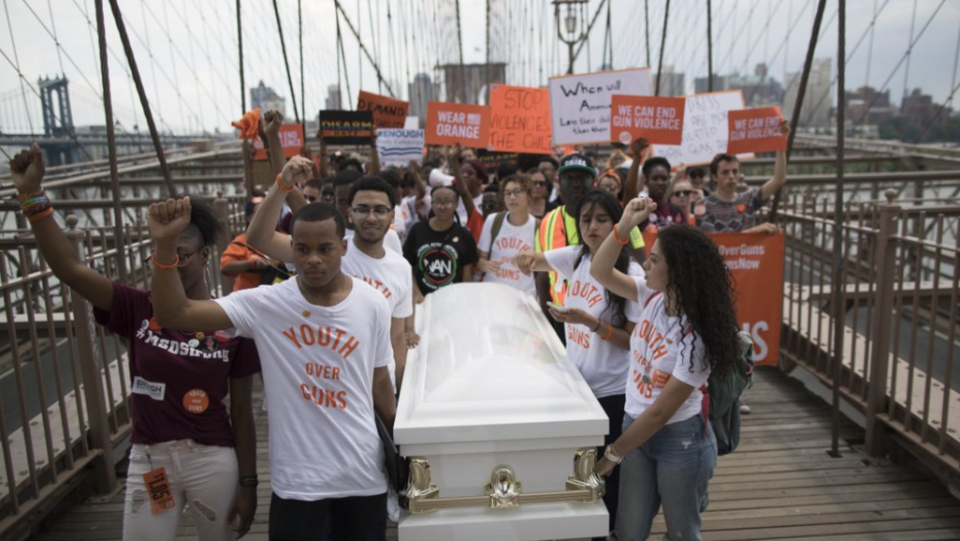
Under capitalism, industrial production and consumer buying expand. Greenhouse gases fill the atmosphere, the climate changes, and people die. U.S. leadership of global capitalism leads to wars and from there, potentially, to nuclear annihilation.
There is extra dying in the United States now. According to provisional government statistics released in August, life expectancy at birth (LEB) was 76.1 years at the end of 2021—just as it was in 1995. LEB was 77.0 years in 2020 and 78.8 years in 2019. This “was the biggest two-year decline in life expectancy since 1921-1923.” Revised figures released in December placed LEB for 2021 at 76.4 years.
Deaths from COVID-19 infection contributed to declining LEB. The U.S. rate of 332.81 COVID deaths per 100,000 population is the 16th-highest rate in the world. Also contributing are “diseases of despair”—substance abuse, accidental drug overdose, alcoholism, and suicide. The victims are mostly working-age adults.
New mothers are dying because of preventable complications of pregnancy and childbirth. Data suggest racism and flawed health care. In the Netherlands in 2020, 1.2 mothers per 100,000 live births died from illnesses related to childbearing. In the United States that year, 55.3 Black mothers and 19.1 mothers in general died per 100,000 live births. Data from 2018 show 55 nations with lower maternal mortality than that of the U.S.
During most of the COVID pandemic, Black people died at two or more times the rate of infected white people. Now the cumulative death rates of the two groups are similar, with 355 deaths of whites and 369 deaths of Blacks per 100,000 population. Cumulative COVID deaths for American Indigenous peoples register at 478 deaths per 100,000 population. Vaccine skepticism may account for increased vulnerability of whites.
The pandemic aside, Blacks and American Indians live far shorter lives than white people do. Hispanics live a little longer. As reported in October 2022, LEB for Hispanics is 77.7 years, for white people 76.6 years, for Blacks 70.8 years, and for American Indians 65.2 years. In 2020, 65 nations showed longer LEB than did the United States.
At issue is capitalism’s role in the shortened U.S. LEB. At work are actions taken to increase profits and accumulate wealth. To succeed in that requires reduced spending for healthcare generally, or healthcare funds going into profit-seeking channels, or diminished support and funding for non-remunerative healthcare activities.
The first possibility disappears at once: The United States is by far the top healthcare spender among all countries of the world. Paying $12,914 per capita on healthcare in 2021, the U.S. was well ahead of second-place spender Germany whose per capita outlay was $7383. Spending on healthcare in 2021 amounted to $4.3 trillion, which is 18.3% of the U.S. Gross Domestic Product. In 2018 the U.S. alone accounted for 42% of healthcare spending in the world.
No question: spending on healthcare in the United States is a money-maker. One sign is the exorbitant pricing of drugs, medical equipment, medical insurance, and services provided by hospitals and outpatient facilities. Executives of medical supply and pharmaceutical companies, specialty physicians, and administrators of hospitals and healthcare networks receive very high salaries.
Profit-making hospital chains, health insurance companies, and pharmaceutical companies generate enough revenue to allow for stock buybacks and dividend payments. Over nine recent years, 14 pharmaceutical companies spent $747 billion for that purpose. Payments to private insurance companies and private hospital networks are large enough to cover high administrative costs and profit-taking.
Instances abound of providers and healthcare institutions steering clear of health-promoting activities that promise little or no economic return:
- The public health sector, charged with health education and illness prevention, is a low priority item. Inadequate preparation and preventative measures accounted in large measure for the U.S. COVID-19 debacle.
- Insurance companies dedicate much effort to denying coverage for particular diagnostic and therapeutic interventions, and often succeed.
- Multi-hospital, multi-service conglomerates are cutting back on health services in rural and economically depressed areas because of decreased “productivity.”
- Many hospitals have recently dropped children’s hospital services as being less remunerative than care for hospitalized adults.
- Small rural hospitals unable to pay their bills have been closing down in droves throughout the nation, depriving area residents of care.
- Specialty practitioners and hospitals often prioritize medical procedures and high-technology diagnostic modes over less remunerative care based on provider-patient interaction and communication.
- Many physicians at the earliest stages of their development opt for a specialty rather than a primary-care career, often because of income considerations. Primary care physicians now comprise only 20% of all U.S. physicians.
- Diminished emphasis on a “medical home,” that hallmark of primary care, opens the door to care that is inefficient and of low quality.
- Compounding matters is that 25 million working-age adults in the U.S. had no health insurance in 2021, and 23% of them were inadequately insured. Care for them is unavailable or fragmented.
Caution is in order: The U.S. record of diminishing LEB and a profiteering healthcare system does not necessarily characterize the healthcare systems of other capitalist countries. The average per-capita health spending of eight European countries plus Australia and Japan, all of them capitalist and wealthy, was $6003 in 2021; they showed an average life expectancy of 82.4 years. Japan, notably, spent $4666 per capita on healthcare; LEB was 84.5 years.
Capitalism operates under restraints in those countries. Their labor unions are stronger than those in the United States. Social democratic political parties and labor parties have been active. In such circumstances, even under capitalism, healthcare gets protection as a public good and is not automatically given over to money-making.
There’s more to the story. Steven Woolf, the retired founder and director of Virginia Commonwealth University’s Center on Society and Health, recently told an interviewer that healthcare is “only a partial answer” to the problem of early deaths. It “accounts for about 10 to 20 percent of health outcomes.”
He indicated that, “Our health is really shaped by our living conditions, jobs, the wages we earn, our wealth accumulation, the education that enables us to get those jobs… The country that we live in is the richest in the world, but we have the highest level of income inequality. So, much of the resources that we need for a healthy population are not available to most of the population.”
The implication is that the United States represents an unvarnished, unrestrained, extreme kind of capitalism. In that setting, the masters of U.S. society could easily accept not only reduced U.S. life expectancy, but also die-offs from climate disaster and from wars and nuclear war.
And consider this: Many titans of industry, represented in Congress by the Republican Party, want to abolish Social Security and Medicare, two of the largest programs helping to grant seniors a long, healthy life. Raising the eligibility age to 70 would have a catastrophic impact on life expectancy. Doing away with these earned benefits and privatizing health care would further condemn Americans to a shorter, sicker, more brutal existence.










